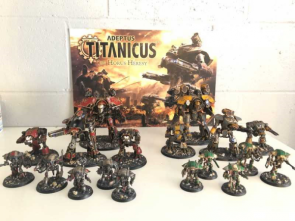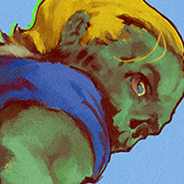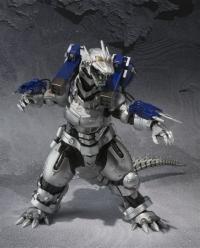Heavy metal thunder.
The Legio Gryphonicus Reaver charges and punches the Legio Mortis Warhound right in its gold-trimmed canine face. The concussive force of the Power First spins the Warhound 45 degrees and forces it into a collision with a Mortis Warlord, damaging both titans. The Reaver fires the Turbo Laser Destructor mounted on its other arm, making an aimed shot right at the Warhound's critically-damaged head. It hits true, the catastrophic damage blows its head off and sending the Scout-class titan reeling. But not before its systems (and Machine Spirit) go haywire and it Wild Fires its double Vulcan Mega-Bolters - right into its allied Warlord, ripping its shields to pieces and damaging its body. The Warhound stumbles forward, and slumps against a nearby building and falls silent. Engine kill.
The above scenario was just one awesome sequence in a game of Adeptus Titanicus that had at least three other awesome sequences of this caliber. Designed- uncredited- by James Hewitt and others unheralded for Games Workshop, Adeptus Titanicus is among the best miniatures games I have ever played. It's a rare example of a tabletop rules set that perfectly balances cinematic, granular detail with supreme rules accessibility. It's shockingly concise, easy to play, and it tells vivid stories without burdensome administration, excessive components, or endless keywords. It does things that far more complicated games (such as Star Fleet Battles) do, accounting for elements such as power and shield management, command, crew actions, damage control, and systemic damage effects but with no more rules than most modern board games. It is fundamentally a low-model-count skirmish game, but one of such epic scope and scale that the smallest unit is bigger than a house.
The combat mechanisms are simple, and most will be familiar to any Warhammer player. Titans are rated for Ballistic and Weapon skills, typically 3+ or 4+. A weapon has a number of dice it rolls looking for these numbers, with bonuses and penalties for range and cover, which is measured at -1 and -2 for 25% and 50% estimated cover respectively. Once the hits are decided, the target makes Void Shield saves to remove hits unless the attack is within 2" - thus within the shield barrier. Anything that gets through the shields hits armor, which means you roll a location dice (provided it is not a targeted shot) to determine where the attack lands. The Weapon's strength is added to a damage roll for each hit, with bonuses for attacking from the flank or behind.
Damage is tracked on a Terminal board for each Titan along with other key information such as the Plasma Reactor and Void Shield levels. Once the head, body, and legs start taking damage, bonuses start to accrue on these armor rolls and eventually hits are marked on a three-space critical damage area. This is when systems start breaking down, the Princeps gets KO'ed, that kind of thing. Weapon locations are on cards, and flip over to show when they are disabled. They can also be destroyed and explode.
As for the rest of the design, classical wargaming elements such as positioning, maneuver, range, facing, and cover are critical as are making measured risks. The Plasma Reactors that power these monsters can be pushed to gain a few extra inches of movement or to make a few more 45 degree turns or you might choose to select Maximal Fire on a Sunfury Plasma Annihilator, but you might wind up squandering energy or potentially damaging your Titan. In the Repairs phase, you'll find yourself weighing out the need to vent Plasma to cool the reactor or ordering the onboard Servitor Clades to raise the Void Shields. Or there could be critical systems damage that needs to be repaired. You can issue special orders during the Strategy Phase that kicks off each round, but you'll have to decide whether getting a "First Fire" shot off with an Apocalypse Missile Launcher or Belicosa Volcano Cannon is worth sacrificing a move that turn, or if a total Shutdown order is a strategic option. That is, if you make the Command roll at all.
Part of the genius of this design is that there is so much space for very serious, heads-down strategic and tactical gameplay that rewards smart piloting while still allowing for the game to be, well, a Games Workshop game. Things can get crazy, thanks to a special die roll when you push the reactors that may have unexpected consequences such as awakening your Titan's Machine Spirit. The Catastrophic Damage table, which dictated that the Warhound above wild-fired and fell down, is unpredictable and dangerous in the best way - when a Titan dies, you don't just take it off the table and lay it to rest in the Battlefoam. Bad things happen. Funny things happen. There are Strategem cards that allow for Orbital Strikes, Mines, and Sabotage to ruin the best plans of Princeps and Moderatii. And for good measure, the classic GW scatter die and blast template mechanism is included so you can accidentally blow up your own Knight banner from time to time. As in all of GW's best games, there is a darkly comic levity to the grimdark atomsphere.
It's all really quite simple, direct, and easy to manage even for newcomers. I think this is very much a "pick up and play" wargame suitable for casual play, and my nine year old had no trouble whatsoever digging right into it. It is not, however a "light" game and in fact its strategic weight provides for a very compelling, engaging experience that really sells the concept of how these war machines fight, their limitations and advantages as well as their terrifying potential for apocalyptic destruction. The game creates a sense of awe and wonder, which is surprisingly uncommon in game design. I've walked away from every game of Adeptus Titanicus shaking my head, laughing, and saying "I can't believe that happened".
Yet for all of my praise directed at how accessible and appealing the game is, it is also fundamentally inaccessible and for some folks it may even be off-putting. The biggest issue is the price, which is of course always in the mix when discussing GW games. Many- including myself- saw the $250 price tag of the now-unavailable Grand Master's Edition (which included two Warlords, two knight banners, terrain, and everything needed to play) and balked. But that was a bundle-priced intro product. These days, GW is selling a "Princeps Collection" set of rules, components, a much smaller terrain set, a Warlord, a Reaver and a kit of two Warhounds for $270. Let's go ahead and call that $305 because you want at least one $35 Knight Banner.This game is too expensive, even though most board gamers wouldn't blink an eye at paying that much for the latest Kickstarter junk.
The other potentially terminal issue is that this is definitely not an option for those who do not want to model or paint. Given the cost, I would not advise anyone to get into this game with the expectation of playing with unpainted $110 polystyrene gray Warlords. This is not a gatekeeping comment; it's a recommendation to spend your hobby dollars more smartly as AT is a waste of money if you are not into the hobby side of tabletop gaming. Battletech, which is also an excellent game with a great new starter edition just out, is a much better choice for those who do not want to get involved with building and painting these models.
With that said, I think these are some of the best models that GW has ever produced - they are really fun to put together, and I've enjoyed painting them more than any other miniatures I've ever painted. Don't be intimidated by them- they are easier to paint than they look. I think they are as easy to paint as Space Marines, to be honest, and even if you don't have the confidence to do the checks or hazard stripes there are plenty of opportunities in the details to be creative and customize each Titan to be unique. And the pride you'll feel when your one-of-a-kind Reaver chin-checks your friend's Warhound just adds to the glorious fun and heavy metal excitement this outstanding mech game delivers.
 Games
Games How to resolve AdBlock issue?
How to resolve AdBlock issue? 


























